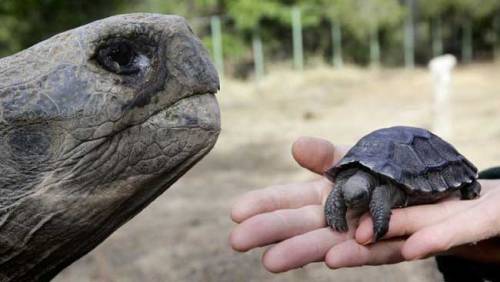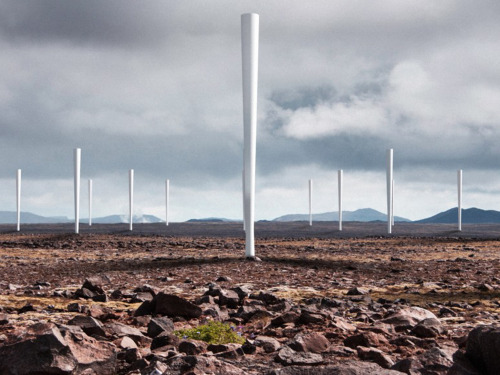This Is On Bloomberg, This Is Not About The People Who Do Things Out Of An Ideal For The Greater Good

This is on Bloomberg, this is not about the people who do things out of an ideal for the greater good but out of self interest. Once those fuckers are captured, as they are the ones calling the shots, progress can happen fast. Potentially!
More Posts from Dotmpotter and Others

Baby Tortoises Show Up In The Galapagos For The First Time In Over A Century
There hadn’t been one single baby tortoise sighting in more than a century on the Galapagos Island of Pinzon, until a small group of the tiny, shelled youngsters were spotted this year.
The recent births are helping to pull the critically endangered animals back from the brink of extinction after they were nearly laid to waste as a result of human activity.
This is huge news for a species that has been struggling to survive for a century, relying on humans raising young tortoises bred in captivity until they are large enough to not fall prey to rats and predators.
“A little chocolate won’t do any harm.” You’ve likely heard your chocolate-loving friend utter this sentence on more than one occasion, or maybe it’s a mantra that you use yourself. But frankly, it undersells chocolate’s myriad benefits. This sweet is capable of much more than simply “not harming” you – it can help you. In fact, there are scientifically-backed studies that prove chocolate can help you live a better life (and we’re not just talking about the happiness you derive from its deliciousness).
On a fossil-hunting trip with her family, five-year-old Daisy Morris found the remains of a previously undiscovered dinosaur, which is now named Vertidraco daisymorrisae. The new dino is not only a previously unknown species, but an unknown genus, making Daisy’s find a really big deal. It’s a pterosaur — a winged flying dino — about the size of a crow, which lived 115 million years ago.






Coating Makes Steel Tougher, Keeps Microbes From Sticking
More and more objects are getting superhydrophobic coatings that make liquids bounce right off. Surfaces with complex nanoscopic structures that prevent wetting will soon be deployed on wind turbine blades and aircraft wings to prevent ice from sticking, and even concrete is being doped with superhydrophobic compounds to help it last decades longer.
Much still needs to be done, though, to strengthen these coatings because any damage can remove the ability to repel liquids. Such an advance is hugely important since there are potentially life-saving healthcare applications if this hurdle could be overcome with a stable, nontoxic coating for steel. Just imagine if implants, scalpels and other tools used on patients had a surface impossible for infection-causing microbes to cling to.
Now, Joanna Aizenberg and her colleagues at Harvard’s Wyss Institute for Biologically Inspired Engineering have demonstrated a possible solution. They’ve been able to coat stainless steel with nanoporous tungsten oxide, which repels all liquids. What’s more, the surface is extremely tough, maintaining superhydrophobicity even after being scratched with sharp steel objects and diamond.
Keep reading

Planetary Resources reveals first object 3D printed from alien metal Space and 3D Printing are connected… http://ift.tt/1Zf3uQr

Bladeless wind turbines generate electricity by shaking, not spinning
Scientists hope to hugely reduce the cost of wind energy by removing the blades from wind farms, instead taking advantage of a special phenomenon to cause the turbines to violently shake.
Vortex, a startup from Spain, has developed the tall sticks known as Bladeless — white poles jutting out of the ground, that are built so that they can oscillate. They do so as a result of the way that the wind is whipped up around them, using a phenomenon that architects avoid happening to buildings and encouraging it so that the sticks shake.
They do so using vortices, which is where the company gets its name from. The bladeless turbines use special magnets to ensure that the turbines are optimised to shake the most they can, whatever speed the wind is travelling at.
As the sticks vibrate, that movement is converted into electricity by an alternator.

A new online platform to promote women’s economic empowerment is here! UN Women and the Government of Canada recently launched an online platform, the Global Knowledge Gateway for Women’s Economic Empowerment, which aims to re-vitalize women’s economic empowerment by building connections, and providing users with tools and resources necessary to be empowered. Get the link to this exciting new initiative here: www.empowerwomen.org
The Most Metal Mass Extinction Events, Ranked
in the style of The Toast
That One Unnamed Extinction Event That Happened When Blue-Green Algae Discovered Photosynthesis and Started Pumping the Environment Full of Oxygen, Which Was Toxic to All Other Life on Earth at That Point in Time
This extinction event did result in the extinction of more living organisms than any other, whether you rank by number of individuals, number of orders/genera/species, % of life, or amount of biomass, but they were all single-celled organisms, so they don’t even register on the metal scale.
The Current Slow Slide Due to Anthropogenic Environmental Modification
Habitat destruction isn’t very metal.
Late Devonian
Some super-weird shit died out, which is totally metal, but we have no idea why, which isn’t. It might not even have been an extinction event, just a decrease in the speciation rate. Jawed vertebrates totally unaffected.
End Ordovician
Second-largest extinction event after the End Permian (not counting those blue-green algae fuckers). Caused by tectonic plate shifting (kinda metal) and resulting glaciation (mildly metal).
Deep Impact
Pros: Giant asteroid hitting the earth.
Cons: Fictional.
End Triassic
Probably caused by massive volcanic eruptions, which is pretty metal, but mostly just wiped out some weird looking amphibians, which is only mildly metal.
End Permian
Greatest extinction event of all time (with the exception of that blue-green algae fiasco mentioned above), wiping out ~95% of all species: metal. Only known mass extinction of insects: metal. Probably caused by the biggest volcanic eruptions since life began (metal) which ignited massive coal beds (metal) and caused the release of methane from the ocean floor (metal) resulting in a runaway greenhouse effect that raised the average ocean temperature to 40C for several million years, essentially boiling the earth alive (super metal). Paved the way for dinosaurs to take over the earth: metal. Known as the ‘Great Dying’: totally metal.
However, most of the extinctions occurred in sessile marine organisms, which are way too boring to be metal, and for the first ~20 million years after the extinction event, land was dominated by Lystrosaurus, which is the most un-metal looking reptile you can think of.
End Cretaceous, aka the K-T Event
A GIANT FLAMING BALL OF ROCK HIT THE EARTH AND KILLED ALL THE (non-avian) DINOSAURS. ENOUGH SAID.
Researchers at MIT have developed a new method for harnessing energy generated by very small bending motions, which could be capable of harvesting power from a broader range of natural human activities such as walking and exercising.
Yale Environment 360: New Device Harvests Energy From Walking and Exercising, Researchers Say

A good way to remember the human bones in the body. Dope pic
www.learninghumananatomy.com
-
 dotmpotter reblogged this · 9 years ago
dotmpotter reblogged this · 9 years ago -
 urbanoceanix reblogged this · 9 years ago
urbanoceanix reblogged this · 9 years ago -
 elevatestructure liked this · 9 years ago
elevatestructure liked this · 9 years ago -
 oycgwg reblogged this · 9 years ago
oycgwg reblogged this · 9 years ago